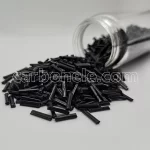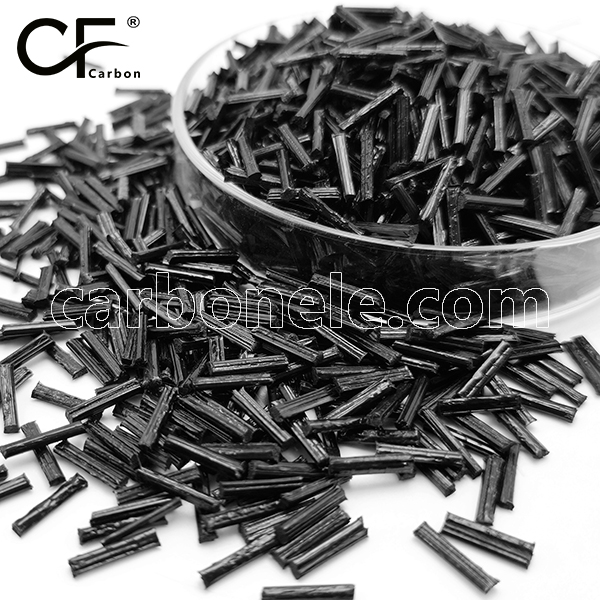
ANTI Static NYLON 6 PA6 LCF5 5% Long Carbon Fibers
Anti-static Nylon 6 PA6 LCF5 combines the benefits of Nylon 6 with Long Carbon Fiber reinforcement and anti-static capabilities, making it a versatile material for applications across electronics, automotive, industrial, consumer goods, and medical sectors.
- Manufacturer: Carbon New Material
- OEM/ODM: Acceptable
- Color: Black
- Free Samples: ≤25kgs
- MOQ: 100kgs
- Port: Xiamen
- Model No.: PA6-LCF-BCA05
What’s it?
Anti-static Nylon 6 (PA6) LCF5 refers to Nylon 6 reinforced with 5% Long Carbon Fiber (LCF) and engineered to possess anti-static properties. This material combines the inherent strengths of Nylon 6 with the benefits of carbon fiber reinforcement and anti-static capabilities, making it suitable for diverse applications across various industries.
Why to choose it?
Characteristics
1. Mechanical Properties: The addition of 5% Long Carbon Fiber enhances the mechanical properties of Nylon 6, providing increased stiffness, strength, and dimensional stability compared to unfilled Nylon 6. This makes it suitable for applications requiring robustness and load-bearing capacity.
2. Anti-static Properties: Anti-static additives or treatments incorporated into the material impart a controlled level of electrical conductivity. This prevents the buildup of static electricity, reducing the risk of electrostatic discharge (ESD) in sensitive electronic environments.
3. Thermal Stability: Nylon 6 inherently offers good thermal stability, and the addition of carbon fiber further enhances its ability to withstand elevated temperatures without significant deformation or loss of mechanical properties. This makes it suitable for applications exposed to varying thermal conditions.
4. Chemical Resistance: Nylon 6 LCF5 exhibits good resistance to many chemicals, oils, and greases, enhancing its suitability for industrial applications where exposure to different substances is common.
5. Dimensional Accuracy: The combination of Nylon 6’s inherent dimensional stability and the reinforcement provided by Long Carbon Fibers results in minimal shrinkage and excellent dimensional accuracy in molded parts.
6. Surface Finish: Parts made from Anti-static Nylon 6 PA6 LCF5 typically have a smooth surface finish, making them suitable for applications where aesthetics are important.
Where to use it?
1. Electronic and Electrical Components: Due to its anti-static properties, this material is ideal for manufacturing components used in electronics and electrical applications. Examples include housings, connectors, and parts for electronic devices where static electricity must be controlled to prevent damage to sensitive components.
2. Automotive Industry: In automotive applications, Anti-static Nylon 6 PA6 LCF5 can be used for various structural components where high strength, stiffness, and dimensional stability are required. Examples include engine components, brackets, and housings.
3. Industrial Machinery: Parts and components requiring good mechanical properties, chemical resistance, and anti-static characteristics benefit from this material. Applications include gears, bearings, and housings in industrial machinery.
4. Consumer Goods: Sporting goods such as racquet frames, bicycle components, and outdoor equipment benefit from the lightweight yet strong properties of Anti-static Nylon 6 PA6 LCF5. Its anti-static feature also makes it suitable for consumer electronics casings and accessories.
5. Medical Devices: Components in medical devices where static electricity could interfere with electronic functionality or patient safety can utilize Anti-static Nylon 6 PA6 LCF5. Its mechanical properties and biocompatibility (depending on specific grades) make it suitable for certain medical applications.
What are development trends?
1. Increased Application in Electronics: With the growing complexity and miniaturization of electronic devices, there is a rising demand for materials that can provide both mechanical strength and anti-static properties. Anti-static Nylon 6 PA6 LCF5 is poised to meet this demand, offering a balance of performance and conductivity.
2. Enhanced Formulations: Ongoing research and development focus on improving the conductivity and mechanical properties of anti-static materials like Nylon 6 PA6 LCF5. Future formulations may aim to achieve higher levels of conductivity while maintaining or enhancing other desirable characteristics.
3. Sustainability: Like other materials, there is a trend towards developing sustainable versions of Nylon 6 PA6 LCF5. This includes using recycled carbon fiber or incorporating bio-based Nylon 6, reducing environmental impact while maintaining performance.
4. Customization and Tailored Solutions: As industries demand more specific performance criteria from materials, including anti-static properties, manufacturers are likely to offer more customization options. This trend could lead to tailored formulations of Anti-static Nylon 6 PA6 LCF5 to meet niche application requirements.
5. Integration in 3D Printing: As 3D printing technologies advance, there is potential for Anti-static Nylon 6 PA6 LCF5 to be used in additive manufacturing processes. This could enable rapid prototyping and customization of parts with anti-static properties, catering to diverse industry needs.
If you had any questions or interest in the type of composites, please feel free to contact us at any time.
Click here to read more about CFRTPs, please.
PA 6 LONG CARBON FIBER 5%
PA6 LCF5 offers enhanced strength, stiffness, and dimensional stability due to its 5% Long Carbon Fiber reinforcement. It's ideal for applications requiring lightweight yet durable components in industries like automotive, aerospace, and industrial machinery.



Frequently Asked Questions
Carbon (Xiamen) New Material Co., Ltd. aims to provide buyers with "one-stop" worry-free high-quality services. Here you can find all information about carbon fiber engineering plastics. If you still have questions, please send us an email for consultation!
-
How can I contact the manufacturer of a product that interests me?
When you find a product you are interested in, you can contact the manufacturer directly by sending an email and we will get back to you as soon as possible.
-
How do I find the products that interest me?
All you need to do is enter the keyword, product name in the search window and press the Enter key on your keyboard. Your search results page will then be displayed. You can also search within the product category pages on the home page. Each category is divided into subcategories, allowing you to refine your search and find products that interest you.
-
Where will I find a buying guide?
Please contact our after-sales service directly and we will provide you with a comprehensive operating guide.
-
What are CF Reinforced Thermoplastic Composites?
CF Reinforced Thermoplastic Composites are materials where carbon fibers are incorporated into a thermoplastic matrix. They combine the strength and stiffness of carbon fibers with the processability and recyclability of thermoplastics. For instance, they are used in automotive parts like bumper beams.
-
What are the benefits of CF Reinforced Thermoplastic Composites over traditional composites?
The key benefits include faster production cycles, easier recyclability, and better impact resistance. They also offer design flexibility. An example is in the manufacturing of consumer electronics casings where complex shapes can be achieved more easily.
-
How are CF Reinforced Thermoplastic Composites processed?
Common processing methods include injection molding, extrusion, and compression molding. Injection molding is widely used for mass production. For example, in the production of small components for the medical industry.
-
What industries use CF Reinforced Thermoplastic Composites?
They are utilized in aerospace, automotive, medical, and sports equipment industries. In aerospace, they can be found in interior components. In the medical field, they might be used in prosthetics.
-
How does the carbon fiber content affect the properties of the composites?
Higher carbon fiber content generally leads to increased strength and stiffness but may reduce ductility. A moderate content is often balanced for specific applications. For example, a higher content might be preferred in structural parts of a race car.
-
What are the challenges in using CF Reinforced Thermoplastic Composites?
Challenges include higher material costs, complex processing equipment requirements, and ensuring uniform fiber dispersion. Issues with adhesion between the fibers and the matrix can also arise. An example is in achieving consistent quality in large-scale production.
























